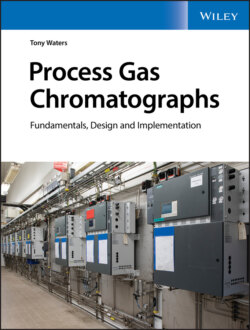Читать книгу Process Gas Chromatographs - Tony Waters - Страница 62
Student evaluation test: SET 02
ОглавлениеYour instructor will provide answers to these questions.
1 S1. What are the two main mechanisms at work in the different kinds of gas chromatographic column?Select the two correct statements:Columns containing a solid stationary phase work by selectively adsorbing components of the sample.Columns containing a solid stationary phase work by selectively dissolving components of the sample.Columns containing a liquid stationary phase work by selectively adsorbing components of the sample.Columns containing a liquid stationary phase work by selectively dissolving components of the sample.
2 S2. Consider the identical molecules within a certain component peak, say, propane. Which of the statements listed here are false?Select the two false statements:If all variables are held constant, identical molecules take the same time to pass through a column.When identical molecules travel through a column, some randomly stay in the liquid phase longer than others do.When identical molecules travel through a column, some randomly stay in the gas phase longer than others do.The width of a peak is due to identical molecules randomly taking different times to travel through a column.
3 S3. What is the effect of temperature and pressure on the solubility of sample gases in the liquid phase?Select the two correct statements:The solubility of a gas in a liquid increases when the temperature is increased.The solubility of a gas in a liquid decreases when the temperature is increased.The solubility of a gas in a liquid increases when the pressure is increased.The solubility of a gas in a liquid increases when the pressure is decreased.
4 S4. When applied to the discontinuous model of chromatography presented in the text, which two of these statements are true?Select the two true statements:When the carrier gas moves, all the sample molecules move with it.Each time the carrier gas moves, the same number of sample molecules move with it.Each time an equilibrium forms, it contains the same percentage of the original sample molecules.Each time an equilibrium forms, the same percentage of the available molecules is dissolved in the liquid phase.
5 S5. Consider a gas‐liquid equilibrium. Which of the statements listed here is true?Select the one true statement:Whenever a gas is in equilibrium with a liquid, 50 % of the gas molecules are dissolved in the liquid.At equilibrium, the liquid phase cannot dissolve any of the sample molecules that are still in the gas phase.At equilibrium, the rate of molecules dissolving in the liquid has become zero.At equilibrium, the rate of molecules dissolving in the liquid is exactly equal to the rate of molecules leaving the liquid phase.
6 S6. For a 10,000‐plate peak having a retention time of 500 s, what is the average time for the column to generate one equilibrium?Your answer must be an integer number of milliseconds.
7 S7. In the example given in Figure 2.9, why is the propane peak exactly halfway along the column when the carrier gas gets all the way through?Select all the correct answers and none of the incorrect explanations:Because, in the example, the propane solubility was adjusted to 50 %.Because, when in the gas phase, the average speed of a propane molecule is half the speed of the carrier gas.Because, on average, the propane molecules stop in the liquid phase for half the time, so they only travel in the gas phase for half the time.Because, in the example, the plate number of the column was N = 5.
8 S8. What change in operating variables might influence the height of a peak on the chromatogram?Select all the correct answers and none of the incorrect answers:A change in the number of molecules of that component present in the injected sample.A change in the width of the peak.A change in the plate number of the peak.A change in the volume of sample injected.
9 S9. This question requires you to make deductions from what you have learned so far.For a particular sample gas, what properties of the gas‐liquid equilibrium are necessary to produce a symmetrical peak?Select all the correct answers and none of the incorrect answers:The proportion of molecules in the gas and liquid phases must remain constant when the component concentration changes.The equilibrium must form very rapidly so more equilibria occur while the peak is in the column.The overall time the molecules spend in the gas phase must be equal to the time they spend in the liquid phase.The solubility of the sample gas must not change with its concentration.
